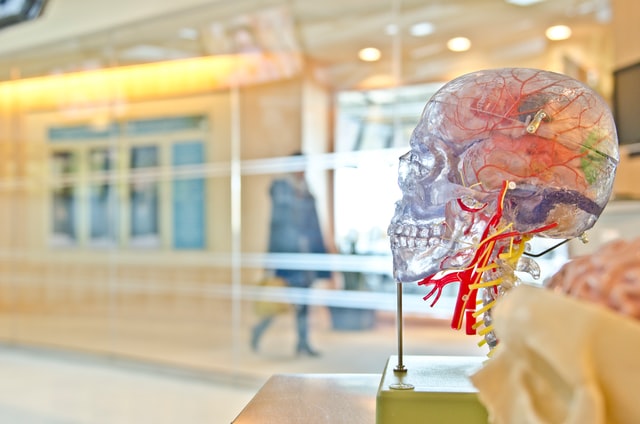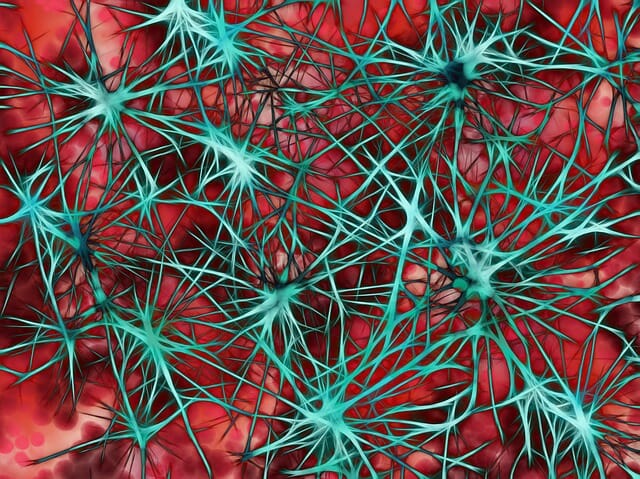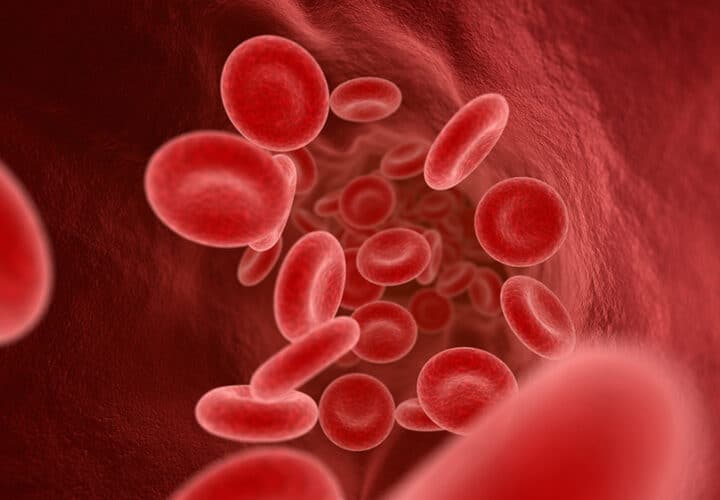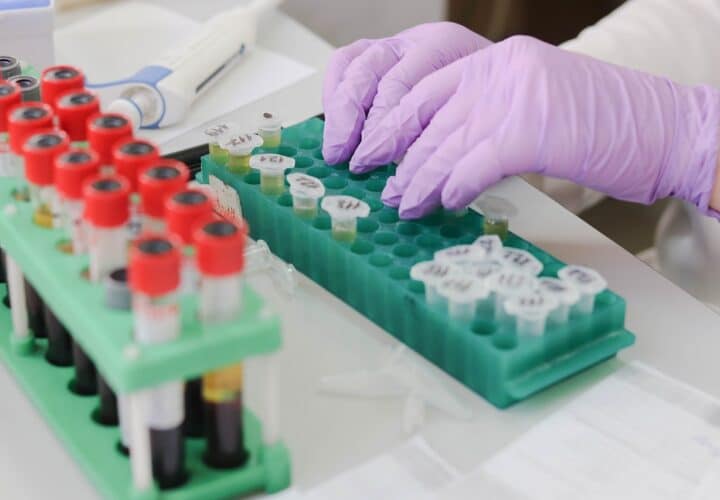Scientists are developing new types of tests and diagnostic tools to make diagnosis easier, more accessible, and more accurate. Here are five different methods for the present and future.
Alzheimer’s disease affects one in 10 people over the age of 65, but testing for a definitive diagnosis is difficult. As of now, no test can give a definitive Alzheimer’s diagnosis, but brain scans are used to supplement findings of memory tests or other symptoms of memory loss. To fill this gap, researchers have been working to develop and bring to market a plethora of new diagnostic methods that test for Alzheimer’s— including Alzheimer’s blood tests, retinal scans and skin tests — to provide people living with cognitive impairment and their families a confirmed diagnosis.
Better testing methods mean earlier diagnoses. Although receiving a diagnosis may be jarring, it benefits people living with Alzheimer’s by allowing them to access treatment, clinical trials, cost effective treatment plans and to plan for the future.
“There is a great deal of anxiety associated with the uncertainty, particularly on the part of the family members, because they don’t know what’s going to happen, and they don’t know if their loved one might be able to benefit from some other kind of therapy, or if he or she has Alzheimer’s,” said Director of the Blanchette Rockefeller Neuroscience Institute Dr. Daniel Alkon.
He explains that over 500,000 patients are estimated to go to the doctor’s office every year with some form of dementia or complaints of memory loss – one third of them do not have Alzheimer’s, but rather other issues like Lyme disease or vitamin deficiencies.
“They have something else that often can be treated, so you really want to know, whether you’re a patient or a loved one, what the diagnosis really is,” Alkon said. “Without that certainty you’re left in a ‘neverland’ of not knowing how to proceed.”
1. Brain Scans
Currently, brain scans are one of the few options available for an Alzheimer’s diagnosis. Although diagnoses are finalized through autopsies after someone has passed away, doctors use brain scans—such as the computerized tomography (CT) scan, magnetic resonance imaging (MRI) or a positron emission tomography (PET) scan—to have a look inside of the brain for atrophy of the hippocampus, or shinkage, as a marker for Alzheimer’s disease.
A CT scan is used to rule out other causes of dementia, such as signs of a stroke, a brain tumor or a hematoma (bleeding out of blood vessels), while an MRI scan is a non-invasive scan used to check for abnormalities in the brain consistent with someone who has mild cognitive impairment (MCI), but is only a precursor to a potential Alzheimer’s diagnosis.
On the other hand, CT scans and MRI’s do not show the beta-amyloid plaque build-up necessary for a confirmed diagnosis, unlike a PET scan.
A PET scan can exhibit the beta-amyloid plaque build-up using C-11 PIB, a material injected into the bloodstream to highlight the affected area, and can diagnose Alzheimer’s in its early stages, even before symptoms appear. A PET scan like this can cost as much as $5,000 and are usually not covered by insurance, barring people from access due to high costs.
A study last year found that PET scans looking at amyloid plaque build-up may not be as reliable as once believed, but focusing on a person’s glucose consumption and its effect on neurons is. Using fluorodeoxyglucose (FDG), or measuring using glucose consumption, is a more focused brain scan than basic amyloid scans, as amyloid scans can detect symptoms that are very mild or very severe, while the brain’s glucose consumption can be more accurate in detecting levels of cognitive impairment.
Depending on where someone lives, accessing this kind of testing can be difficult.
2. Blood Tests
In February of 2020, a study was conducted using blood tests to confirm an Alzheimer’s diagnosis. This test looked for core Alzheimer’s biomarkers, such as beta amyloid and tau, in plasma by using carbon nanotubes to increase the accuracy of the test. Overall, researchers found that by measuring these biomarkers in human plasma during clinical trials, there was a clear separation from people living with Alzheimer’s and the control group of healthy people, with an accuracy of 88.6%.
Tau is an important marker for blood tests, as it was found that one specific variant, P-tau181, is elevated in patients who have beta-amyloid plaques, an indicator of Alzheimer’s. Once they are available to consumers, blood tests will be able to find the plaques at the early stages of the disease, which could give patients more options, such as participating in clinical trials, that might assist in research and improve the chances of medical intervention.
Blood tests for Alzheimer’s are still in their early stages of clinical trials, and are said to not make it to the market for at least five years, but would cost only a few hundred dollars, compared to expensive and invasive brain scans.
3. Retinal Scans
Another form of future Alzheimer’s testing currently being studied is the retinal scan. Scientists have learned that the tissue in the retina contains the same neurons, glial cells, vascular supply and chemistry as the brain, and can exhibit abnormalities in the brain. The best part? Retinal scanning is lower-cost and less invasive than traditional testing.
Dr. Peter Snyder, professor of biomedical sciences at the University of Rhode Island, explained that although these scans could detect signs of Alzheimer’s as early as 20 years before any person develops symptoms, the technology is still going through a five-year trial.
Part of the reason retinal scans are still in development is that while scientists now know that eyes can be windows to the brain, they haven’t identified exactly what in the scan can indicate Alzheimer’s and at which stage the disease has progressed to. In future trials, Snyder hopes that the path will be cleared and a test can be shared with optometry and ophthalmology practices.
“We’re enrolling about a hundred people who we’re going to follow for three years each,” Snyder said. “I think three or four years from now, we’ll be hot on the path to finding the metric or two that is most important and will develop into a useful tool.”
4. Artificial Intelligence Tools
Researchers say that through analyzing blood samples, brain tissue and other methods, artificial intelligence (AI) could help bring patients faster, more accurate, and earlier Alzheimer’s diagnoses. Many believe the technology can catch information that doctors miss, if not replace human doctors in the diagnosis process altogether.
It could also help make diagnosis more accessible and more affordable for patients and health care systems. Most recently, new research from the University of Sheffield’s Neuroscience Institute examined how the routine use of AI in healthcare could help mitigate the expenditure of time and economic impact that common neurodegenerative diseases like Alzheimer’s and Parkinson’s put on the NHS.
The findings, published in July 2020 in the journal Nature Reviews Neurology, further highlight how AI’s machine learning algorithms are able to detect neurodegenerative disorders before symptoms progress. For example, algorithms can listen to patients’ speech patterns, analyze vocabulary and assess other semantic features to measure cognitive function. These technologies can also leverage information embedded in digitized health records or genetic profiles to suggest individualized treatments.
“Most neurodegenerative diseases still do not have a cure and in many cases are diagnosed late due to their molecular complexity,” said lead author Dr. Laura Ferraiuolo from the University of Sheffield. “Widespread implementation of AI technologies can help, for example, predict which patients showing mild cognitive impairment will go on to develop Alzheimer’s disease, or how severely their motor skills will decline over time. AI-powered technologies can also be used to help patients communicate their symptoms remotely and in the privacy of their own homes, which will be an enormous benefit to patients with mobility issues.”
5. Skin Tests
Among the many types of diagnostic tests going through clinical trials right now, a new one is being added to the landscape.
DISCERN™, a test created over 15 years by researchers at the Blanchette Rockefeller Neuroscience Institute and offered by Neurodiagnostics, is a new method to find an Alzheimer’s diagnosis, wherein a small skin punch sample (only three millimeters) is biopsied. The test is done at your doctor’s office and shipped to the Neurodiagnostics laboratory for testing.
The skin sample is incubated in a petri dish, allowing the cells to multiply to over one million. Once the cells are grown, they are tested for three distinct biomarkers of Alzheimer’s as a way to give a definitive diagnosis, rather than finding a diagnosis through process of elimination.
Alkon led a team of scientists to find the three biomarkers. “I put the emphasis on accuracy, and it’s minimally invasive, very much like a blood draw,” Alkon said.
They worked to differentiate Alzheimer’s disease from other types of dementia, with over 95% actually having Alzheimer’s and 95% correctly identified as not having Alzhiemer’s.
Recently, Alkon and his team did a study in collaboration with Harvard, using fresh skin samples that are then frozen, of people who have recently passed with Alzheimer’s and people who did not have Alzheimer’s. They measured the same molecular events identified in skin cells that show the hallmark biomarkers of Alzheimer’s.
Alkon said that his team found some of the exact same hallmarks in Alzheimer’s-positive skin cells that they found in Azheimer’s-positive brain tissue. “So not only are the pathologies of Alzheimer’s disease in the brain as well as in peripheral tissues, but also the deficits and the abnormalities that we see in the skin cells that are also in the brain cells, giving us a little even added confidence.”
UPDATE, 20 November 2023: As of a landmark policy change in October 2023, Medicare now covers beta-amyloid PET scans for diagnosing Alzheimer’s disease.





Is there any Test for someone with dyslexia? Can a test be done in a different way